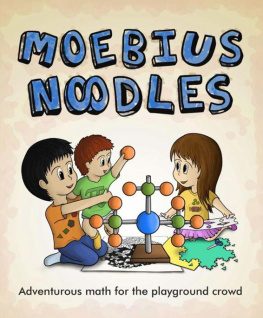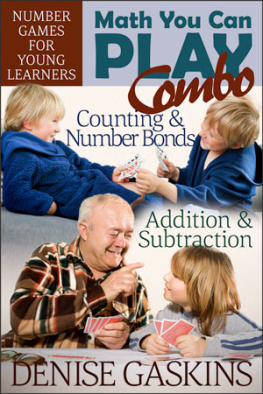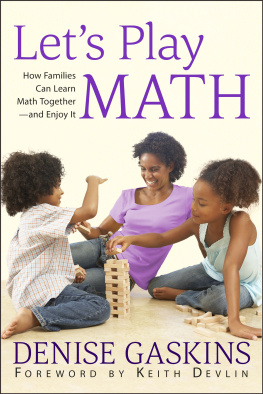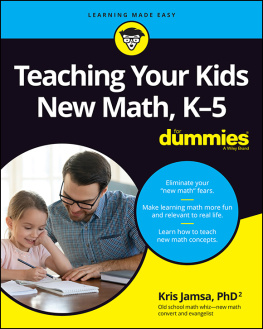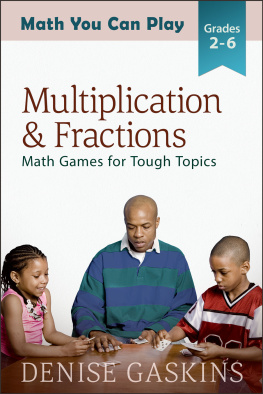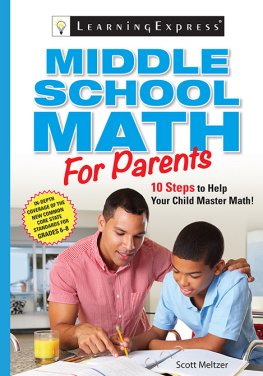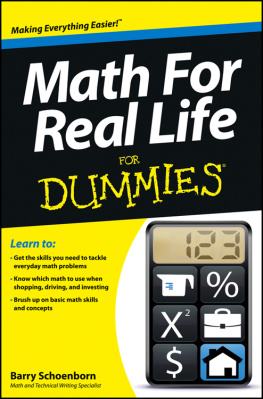Moebius Noodles
Adventurous math for the playground crowd

Creative Commons Attribution-NonCommercial-ShareAlike license by Moebius Noodles.

Others can remix, tweak, and build upon this work non-commercially, as long as they credit Moebius Noodles and license their new creations under the identical terms.
Contact http://moebiusnoodles.com for commercial rights.
ISBN: 978-0-9776939-5-5 (paperback)
ISBN: 978-0-9776939-1-7 (ebook)
Library of Congress Control Number: 2013934669
Text: Yelena McManaman and Maria Droujkova
Illustrations and design: Ever Salazar
Copyedits: Carol Cross
Formatting: Polgarus Studio
Published by Delta Stream Media, an imprint of Natural Math
309 Silvercliff Trail, Cary, NC, USA

Table of Contents
Symmetry
Number
Function
Grid
There are no names on the cover of this book because it would not be possible to fit the names of everyone who helped make it happen. This book came about thanks to the adventurous parents, colleagues, and friends of young math who took our original classes, play-tested our ideas, asked deep questions, crowdfunded the making of the book, guest blogged on our site, shared their concerns, and sent us their and their kids thoughts about the games.

Anonymous
Aaron Silvers
Adam Hansen
Alexander Bogomolny
Alexander Rozenfeld
Algot Runeman
Ali Rosselle
Allison Krasnow
Andrius Kulikauskas
Angela Stauder
Ann Lettes
Anna Weltman
Anne Jeanette Martin
Arkadiy Birger
Axelle Faughn
Barbara Schindelhauer
Bettina Bowers Schwan
Bonnie Crowder
Boris Brodsky
Brad Morgan
Brandy Wiegers
Brenda Weiss
Brian Turley
Colin Chambers
Carles Aguilo Collado
Carol Cross
Chris Hunter
Christian McManaman
Christine Cobb
Colleen King
Dani Novak
Daniel Patterson
David Cordeiro
David Wees
Deborah Cohen
Denise Gaskins
Dmitri Droujkov
Dmitri Kazmin
Dmitry Sagalovskiy
Dor Abrahamson
Elena Bazarova
Elena Koldertsova
Elisa Wing
Elizabeth Ross
Elizabeth Zwicky
Ever Salazar
Fred Bishop
George Vennebush
Gina Goddard
Gordon Hutchinson
Heather Chapman
Heidi Van Natter
Hope McMullan
Hope Thompson
Irina Mokrova
James Laidlaw
Jason Holder
Jenny Eggleston
Joel Duffin
John Domar
John Golden
Julia Brodsky
Joshua Zucker
Kelli Brandon
Kelly Prak
Kialei
Kimberley Meltzer
Kimberly Naylor
Laura Overdeck
Lee Ann Dietz
Lucy Laffitte
Madison Cross Sugg
Malke Rosenfeld
Maria Linnik
Maria Muscarella
Marie Brodsky
Marjalee Smith
Mary Malpezzi
Matt Droujkov
Max Leisten
Melanie Hayes
Michael Rachkovsky
Michael Thayer
Mike Graham
Nancy Ruhana
Nicole Smith
Noelle Cahow
Nora Reynolds
Patrick Honner
Paul Solomon
Pete Longhurst
Porter Family
Richard Elwes
Royce Riddle
Ryan Combs
Sara Joy Pond
Sara McGrath
Science Jim
Sharon Vogt
Sheri Soffian
Sol Lederman
Stacy Perry
Stephen Thomas
Sue Stern
Sue Van Hattum
Suellen DiMassimo
Susan Mygatt
Terri Coons
Vitomir Stojanovski
Zhuo Hong

Why Play This Book
Children dream big. They crave exciting and beautiful adventures to pretend-play. Just ask them who they want to be when they grow up. The answers will run a gamut from astronauts to zoologists and from ballerinas to Jedi masters. So how come children dont dream of becoming mathematicians?
Kids dont dream of becoming mathematicians because they already are mathematicians. Children have more imagination than it takes to do differential calculus. They are frequently all too literate like logicians and precise like set theorists. They are persistent, fascinated with strange outcomes, and are out to explore the what-if scenarios. These are the qualities of good mathematicians!
As for mathematics itself, its one of the most adventurous endeavors a young child can experience. Mathematics is exotic, even bizarre. It is surprising and unpredictable. And it can be more exciting, scary, and dangerous than sailing on high seas!
But most of the time math is not presented this way. Instead, children are required to develop their mathematical skills rather than being encouraged to work on something more nebulous, like the mathematical state of mind. Along the way the struggle and danger are de-emphasized, not celebrated with good intentions, such as safety and security. In order to achieve this, children are introduced to the tame, accessible scraps of math, starting with counting, shapes, and simple patterns. In the process, everything else mathematical gets left behind for when the kids are ready. For the vast majority of kids, that readiness never comes. Their math stays simplified, impoverished, and limited. Thats because you cant get there from here. If you dont start walking the path of those exotic and dangerous math adventures, you never arrive.
It is as tragic as if parents were to read nothing but the alphabet to children, until they are ready for something more complex. Or if kids had to learn The Itsy-Bitsy Spider by heart before being allowed to listen to any more involved music. Or if they were not allowed on any slide until, well, learning to slide down in completely safe manner. This would be sad and frustrating, wouldnt it? Yet thats exactly what happens with early math. Instead of math adventures observations, meaningful play, and discovery of complex systems children get primitive, simplistic math. This is boring not only to children, but to adults as well. And boredom leads to frustration. The excitement of an adventure is replaced by the gnawing anxiety of busy work.
We want to create rich, multi-sensory, deeply mathematical experiences for young children. The activities in this book will help you see that with a bit of know-how every parent and teacher can stage exciting, meaningful and beautiful early math experiences. It takes no fancy equipment or software beyond everyday household or outdoor items, and a bit of imagination which can be borrowed from other parents in our online community. You will learn how to make rich mathematical properties of everyday objects accessible to young children. Everything around you becomes a learning tool, a prompt full of possibilities for math improvisation, a conversation starter. The everyday world of children turns into a mathematical playground.
Children marvel as snowflakes magically become fractals, inviting explorations of infinity, symmetry, and recursion. Cookies offer gameplay in combinatorics and calculus. Paint chips come in beautiful gradients, and floor tiles form tessellations. Bedtime routines turn into childrens first algorithms. Cooking, then mashing potatoes (and not the other way around!) humorously introduces commutative property. Noticing and exploring math becomes a lot more interesting, even addictive. Unlike simplistic math that quickly becomes boring, these deep experiences remain fresh, because they grow together with childrens and parents understanding of mathematics.
Next page
